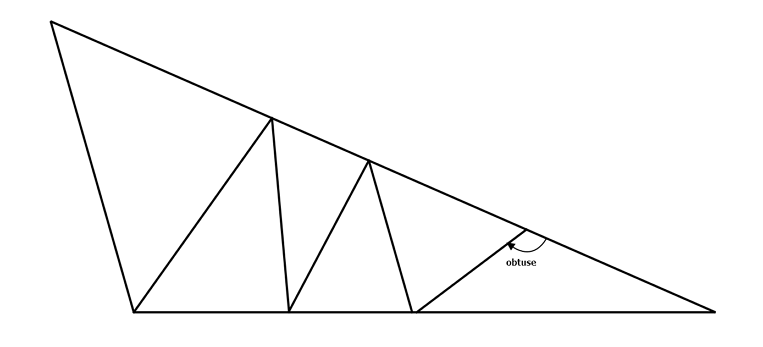Triangle Dissection

What is the smallest number of acute triangles into which any obtuse triangle can be dissected? Or prove the impossibility of it.
Clarification: A right angle is neither acute nor obtuse.
Source: Martin Gardner.
No vote yet
1 vote
Easy Math Editor
This discussion board is a place to discuss our Daily Challenges and the math and science related to those challenges. Explanations are more than just a solution — they should explain the steps and thinking strategies that you used to obtain the solution. Comments should further the discussion of math and science.
When posting on Brilliant:
*italics*or_italics_**bold**or__bold__paragraph 1
paragraph 2
[example link](https://brilliant.org)> This is a quote# I indented these lines # 4 spaces, and now they show # up as a code block. print "hello world"\(...\)or\[...\]to ensure proper formatting.2 \times 32^{34}a_{i-1}\frac{2}{3}\sqrt{2}\sum_{i=1}^3\sin \theta\boxed{123}Comments
Spoiler alert ..... Don't scroll down until you've given up looking for your own proof ...
The answer is 7. Wallace Manheimer came up with the proof back in 1960. Briefly, if we were to draw a line from the vertex at the obtuse angle to the opposite side then either we'd end end up with two right triangles, or one of the partitioned triangles would be obtuse. So then we would have either one or two triangles to dissect into acute triangles, which would result in a non-minimal dissection of the original triangle. So in order to find a minimal solution, the line from vertex at the obtuse angle cannot go all the way to the opposite side.
Now from the endpoint of this abbreviated line must emanate a minimum of 5 lines, (inclusive of the first line from the obtuse vertex), since otherwise not all of the angles at this vertex would be acute. The points where these additional 4 lines intersect the sides of the original triangle can then be joined, resulting in an inner pentagon composed of 5 triangles plus 2 "outer" triangles for a total of 7 acute triangles formed.
Here is a diagram of the minimal dissection "template".
Log in to reply
NICE! The inspiration must have gave it away ahah!
Follow-up question:
Prove that an obtuse triangle ca be dissected into a minimum of 8 acute isosceles triangles.
@Pi Han Goh How do I create a vertical "spoiler gap" in LaTeX?
Log in to reply
Edited it in for you. Essentially you have to tell it to "leave several empty rows", and also force the rows to not be collapsed.
Log in to reply
Great! Thanks for doing that. :)
7